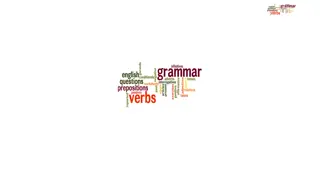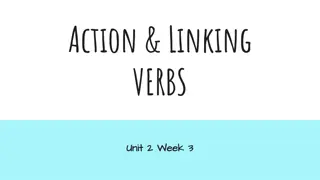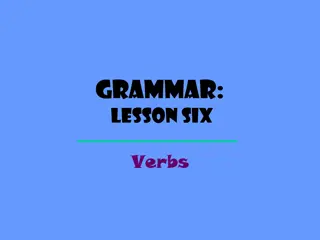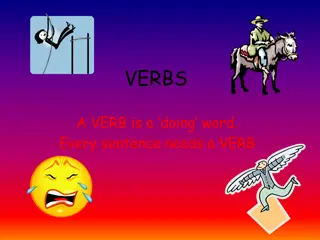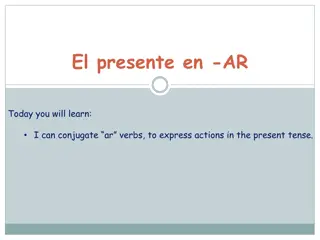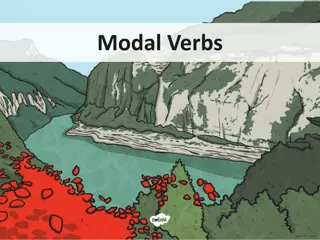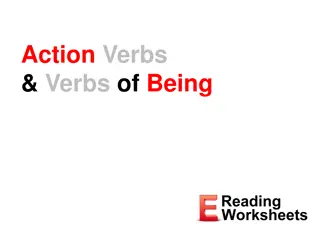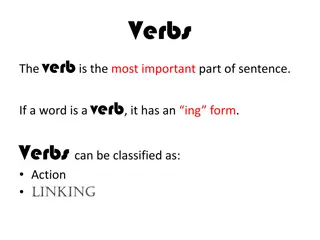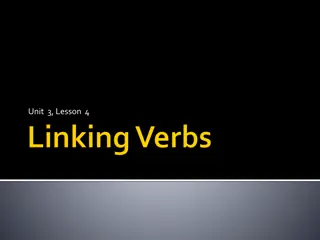Understanding Verbs: Introduction and Identification in English
This lesson introduces verbs in English, covering their meaning, identification, and categorization into linking and action verbs. Students will learn to identify verbs in sentences, distinguish linking verbs from action verbs, and understand the importance of verbs in forming meaningful sentences. The content includes examples, explanations, and illustrations to facilitate comprehension.
Uploaded on Jul 16, 2024 | 0 Views
Download Presentation

Please find below an Image/Link to download the presentation.
The content on the website is provided AS IS for your information and personal use only. It may not be sold, licensed, or shared on other websites without obtaining consent from the author. Download presentation by click this link. If you encounter any issues during the download, it is possible that the publisher has removed the file from their server.
E N D
Presentation Transcript
VERBS TEACHER : EBENEZER AFREH AGYEKUM CLASS : FORM 1
SCOPE OF LESSON Introduction of verbs (meaning and identification) Broad categories of verbs (Linking verbs and action verbs How to identify linking verbs
Objectives By the end of the lesson, the student should be able to: a. identify verbs in given sentences. b. distinguish linking verbs from action verbs in given sentences.
Why are verbs very important in the English sentence? Verbs are important part of speech because without them a sentence cannot exist or cannot be meaningful. Consider the following sentences: Kofi, please leave the room. Kofi, please the room. iii. Leave. i. ii. Which of the sentences is not meaningful? Why is it so?
Sentence ii Kofi, please the room is not meaningful because there is no verb in it. It is the verb in the sentence that makes the speaker or writer communicate meaning to the reader or listener.
Why is sentence iii made up of only one word but is still meaningful? The third sentence even though it is made up of a single word, it is treated as a full sentence and could be meaningful. Why is it so? It is so because that single word leave is a verb. Verbs are the meaning carriers in any sentence. That is why many a time when commands or orders are given to people, they are in the form of single verbs. Eg. Sit! Sleep! Eat!
What then is a verb? A verb is any word that expresses an action or a state of being in a sentence. Eg. He jumped over the wall. (action) They eat everyday. (action) I am a student (state of being) They are my children (state of being)
Any basic sentence in English can be divided into two main parts: a. Subject b. Predicate Example. Anokye goes to school everyday. (Subject = Anokye) (Predicate = goes to school everyday) It could be seen that the word that begins the predicate is a verb - goes
Based on the analysis of the sentence, a verb is also a word that begins the predicate in a sentence. Sometimes the verb in the sentence might be more than one but they are considered together as a single verb phrase. Eg. Ama is going to school. Subject= Ama Predicate = is going to school It could be seen that there are two verbs beginning the predicate is and going When asked of the verb in this sentence, it is (is going).
Identify the verbs in the sentences. 1. Ghanaians are nice people. 2. Fr. Sylvester rewarded the students. 3. Close it.
TWO BROAD CATEGORIES OF VERBS
1. ACTION VERBS This type of verb expresses action in a sentence. (The action may be in the present, past or in the future time) Eg. 1. He always eats at night. 2. He sneezes when he senses perfume. 3. He kicked the ball. All action verbs can have progressive forms (-ing form) Eg. 1. He is eating the food. 2. The students are washing their bowls.
2. LINKING VERBS (Stative Verbs) These verbs do not express any action, they rather connect the subject of the verb to additional information about that same subject. These verbs include a. (the forms of be -am, is, are, was, were) Eg. i. Esi is shopaholic. ii. They are wonderful. iii. I am a man. iii. All the kittens were playful.
NB: Linking verbs are normally not used in the progressive form. Eg. i. Esi ising shopaholic. ii. They areing wonderful. iii. I aming a man. iii. All the kittens wereing playful.
b. Other verbs that can also be used as linking verbs or stative verbs include appear, become, feel, get, grow, look, remain, seem, sound, smell, etc. Eg. 1. Your appear nice in your dress. 2. I feel great this morning. 3. The cake smells good. But wait, did we not first say that linking verbs could not be used in the progressive form? appearing, becoming, feeling, getting, growing, looking, remaining, seeming, sounding, smelling, etc Are these words which have progressive forms still linking verbs?
HOW TO IDENTIFY LINKING VERBS Substitute the verb with one of the forms of the form be . If it fits the substituted verb, then it is a linking verb. If it does not, it is not a linking verb but an action verb.
Example 1: I feel nervous. (is feel a linking or an action verb?) I am nervous. (feel is a linking verb) Example 2: I feel the texture of the sand. ((is feel a linking or an action verb?) I am the texture of the sand.* It therefore, means that feel in example 2 is not a linking verb because it has failed the test. It is rather an action verb.
Exercise 1 State whether the underlined verbs in the sentences are linking or action verbs. 1. He grew tired of running. ( ) 2. They tasted the pizza. ( ) 3. Nketiah loves reading. ( ) 4. The food tasted delicious. ( ) 5. She looks fine. ( )
EBENEZER AFREH AGYEKUM Our Lady of Grace Senior High School Post Office Box MG 107 Mamponteng- Ashanti Email: ebenezerafreh@gmail.com Cell phone: 0541893336


